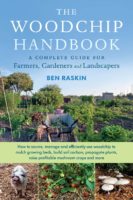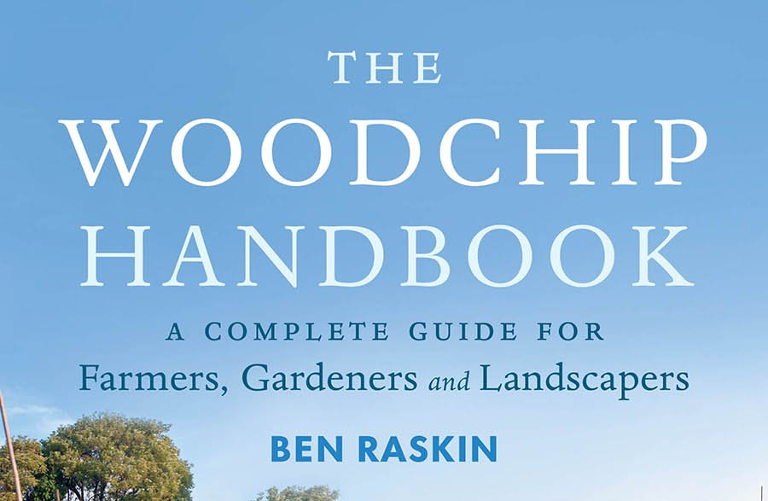 The following excerpt is from Ben Raskin’s new book The Woodchip Handbook: A Complete Guide for Farmers, Gardeners and Landscapers (Chelsea Green Publishing, October 2021) and is reprinted with permission from the publisher.
The following excerpt is from Ben Raskin’s new book The Woodchip Handbook: A Complete Guide for Farmers, Gardeners and Landscapers (Chelsea Green Publishing, October 2021) and is reprinted with permission from the publisher.
The Woodchip Handbook
By Ben Raskin
Restoring Damaged Soil
With the potential for woodchip to boost soil health, hold onto water and promote plant growth, it is a small step to look at how to effectively harness that potential for rescuing degraded and damaged soils. There are numerous examples of how this has been done, and we’ll look at a few of them here. In some of the studies woodchip and biochar are used either comparatively or in combination, and there is certainly potential for combining the shorter-term benefits of woodchip with the longer-lasting properties of biochar. Both the physical and biological properties of woodchip are used in soil remediation.
Bioremediation
We have already seen the potential for woodchip and the fungi that decompose them to absorb potentially polluting nitrates, but there is some evidence that it could be used more widely to help deal with other manmade pollutants, ‘such as chlorinated and non-chlorinated hydrocarbons, wood preserving chemicals, solvents, heavy metals, pesticides, petroleum products, and explosives. There is an even stronger body of evidence on the potential of biochar for this purpose, but creating biochar is more costly and in most cases some of the energy is lost during the production process. Woodchip is cheaper and easier to produce, so it is worth looking at those situations that could use it.
For contaminants that would eventually break down anyway, such as oil and diesel spills, woodchip appears to have the potential to significantly increase the speed at which the contaminants disintegrate. One study showed that adding woodchip at 50 per cent or more boosted the levels of microorganisms capable of breaking down crude oil. Another project looked at compost, fungi and growing willow to remove diesel contaminants from the soil. This method performed better than the industry standard chemical treatments. The woodchip effectively feeds those organisms that can degrade the oil pollutant, multiplying their numbers and so increasing the speed at which they can deal with the problem.
There has been some work looking at using woodchips to help reduce the salinity of soils. They could have a role in preventing damage, for instance in protecting roadside plants from salt spread for de-icing, or in reducing the salination effect of animal manures. Woodchip could even help with reclaimed soils that have excess salt levels. An Australian study found that adding woodchip as part of a combined strategy helped to improve soil structure, enabling increased leaching of salts from the soil surface.
In practical terms, in a farm or garden situation we can look to use woodchip if we have an accidental spill of oil or diesel; or, if you are taking on a site with some history of contamination, using composted woodchip may be a way to reduce the risk associated with this. Contaminated soil fed to rats with and without compost additions showed that the compost held onto the contaminants more tightly than untreated soils, with rats showing no toxic side effects of the compost-treated soil compared to some effects with untreated. In areas that have a history of surface mining, for instance for zinc or lead, this a treatment worth considering.
Woodchip Denitrifying Bioreactors
In the context of soil remediation this type of bioreactor is different from the Johnson-Su reactor described earlier. Here, the term is used to describe a technique of using woodchip to absorb nutrients (and particularly the soluble nitrates and phosphates) lost from farmland. Draining farmland is an important way of making it more productive and suited to cropping and grazing. The Romans used field drains, and in the eighteenth century new designs using bricks and tiles were extensively laid down. Nowadays, land drains are mostly plastic perforated pipe, but the principle remains the same; provide a channel to remove water quickly from wetter fields to prevent anaerobic conditions. One significant consequence, though, is that if there are nutrients in the soil water these will be washed away through the drains and into the rivers. If you force this draining water through a woodchip bioreactor, you can prevent most of that soluble nutrient reaching the river and return it to the land by furnishing a carbon and energy supply to denitrifying microbes. The water needs at least twenty-four hours in the woodchip to effectively take most of the nitrates out, and the woodchip needs to be regularly replaced to stay effective, usually after about four years. On a farm scale you can construct a simple lined bed of woodchip, which you can then cover back up with soil.
Compacted Soils
Compaction is a real issue in many cultivated soils and is often solved by subsoiling, usually involving a deep tine dragged through the soil to break up the compaction. While this does fix the problem temporarily, without a more permanent change to managing the soil, the symptoms will inevitably reoccur. Along with other approaches such as lengthening rotations, growing deep-rooted green manure crops and reducing tillage, adding organic matter will help to reduce compaction. Woodchip has been shown to be effective in restoring wetlands, for example, where other methods might not work, by reducing compaction.
Similarly, in urban soils where there is heavy foot traffic, and little in the way of soil management, compaction is a big challenge. It has the biggest impact on urban trees, which often already have limited soil and water available. In many cities the ever-growing financial pressure of managing street trees has led contractors to pave ever closer to the trunk. However, even where there is still some soil around the tree, there are few options available for effective soil management, given the very tight spaces and lack of available suitable machinery. A study at Morton Arboretum in Illinois concluded that, ‘compost top dressings and wood chip mulches should be used as soil management techniques for trees growing in compacted urban soils,’ and that, ‘it is reasonable to expect that combining wood chips and composts may have even greater benefit for improving soil quality for urban trees.
Erosion
Many of the studies done on using woodchip for erosion control have looked at extreme situations, such as post forest fires or after large areas of trees have been clear-felled. While this is not a replica for most farm and garden scenarios, we can use the knowledge and insight gained from this research to help on smaller-scale erosion challenges, like growing vegetables on sloping land or protecting cultivated arable land.
When we talk about degraded soils, we normally mean that they have lost structure and organic matter. Usually, this is associated with heavy and continuous cropping. In a reflection of how a soil builds from nothing with the gradual undisturbed addition of organic material and subsequent increase in life, if we cultivate and grow crops without adding organic matter, we will gradually reduce that soil back to its mineral content and structure. Without the carbon, air and water held within the soil that are needed to support life, eventually it can become a desert.
Changes in agricultural practice tend to have a greater effect on soils in drier climates where quick recolonization of weeds over bare soil is less likely. On slopes, this can quickly lead to soil loss and further challenges of establishing plant cover. Using a woodchip mulch significantly reduces that erosion and helps to build soil structure and moisture-holding capacity of the soil. In a study in northeast Spain looking at gypseous and calcareous soil post forest fires, a thin mulch, of between 0.5 and 2 centimeters (1⁄5 and ¾ inch), was shown to considerably reduce runoff both of water and sediment.37 They found that you needed to mulch at least 60 per cent of the site and recommended mixing seeds of a suitably adapted plant species into the woodchip. In a farming situation, you could potentially mulch with a thin layer of RCW or composted woodchip on land that was at risk of wind or water erosion. This could be done post-harvest if weather conditions allowed, though it would be tricky in wetter climates after a late-harvested crop. Depending on the following planting, a quick-growing cover crop seed could be added into the woodchip.





